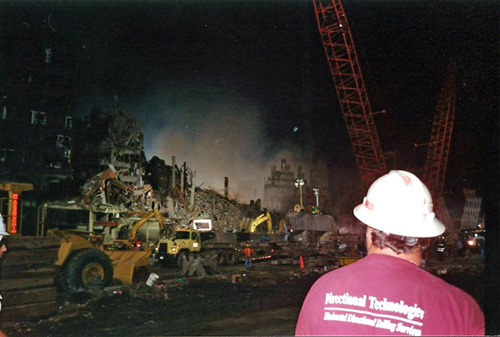On Sept. 13th 2001, Kathy Sequino’s telephone rang.
It was the New York Department of Transportation.
The man on the line had just found Directional Technologies Inc.’s business card ad in the back of Trenchless Technology and he was wondering if Sequino could answer a few questions. He wanted to know if it was technically feasible to drill into the subbasement of the World Trade Center (WTC) using directional drilling technology. He wanted to know if they could bore through concrete walls and tons of steel super structure on the chance that they might locate trapped survivors. He wanted to know if Sequino would help.
The president and owner of Directional Technologies hung up the phone. She conferred with her husband, Mike Sequino, and a few hours later he headed for New York City, 90 miles away.
It had only been two days since hi-jacked airliners full of innocent passengers, had decimated the two WTC towers, symbols of the financial prowess of the Unites States. While most of America, still shell shocked, huddled around televisions waiting for the next bits of news, New York City was busy assembling a elephantine rescue effort for the thousands of missing people.
Directional Technologies was enlisted to help, but the company wasn’t alone. Police, fire and medical personnel along with countless engineers, demolition experts and soldiers were already scouring streets and giving the city support. Amongst these operations, the N.Y. DOT was working on a plan to use a directional drill to burrow through WTC debris in order to insert television inspection cameras and look for victims.

“They wanted us to drill into the subbasement of the World Trade Center,” said Mike Sequino, vice president of Directional Technologies. “We’ve done something similar for remediation purposes. We had to drill through foundation walls. Once we broke through into the subbasement, we would have to extract the drill, mount a camera to the bottom of the drill pipe, reinsert with the camera and look around for voids and survivors.”
Directional Technologies received support from oil field companies like Schlumberger Oilfield Services, Baker Oil Tools, Houston, Geological Boring, Tacoma, Wash., Frank’s Casing Crew and Rental Tools, Lafayette, La., and television inspect companies like Underground Video, Hillsdale, N.J., Downhole Video, Oklahoma City, Hit Well, Lexington Ky., and CUES, Orlando, FLA. Also helping, companies like UEMSI, Northbrook, Ill., donated television inspection cameras for the rescue effort. Sequino reached New York City that same Thursday night. The surrounding buildings around Ground Zero were still collapsing and crews were unable to get close enough to start the operation.
“It got so chaotic. The first night One Liberty Plaza was still unstable,” said Mike Sequino, “They thought the building was coming down. We didn’t even get to talk to anyone Thursday. The rescue team had to worry about building facades falling. They had to worry about buildings falling.”
Rescue efforts continued Friday and Saturday near Ground Zero, but without much success. The team spoke with fire chiefs as workers removed rubble; then crew was looking for a spot close enough to use the drill. By early Monday morning, around 2:30 early Monday morning, around 2:30 a.m. enough debris has been cleared where a target point was being considered, that target point was the remaining portion of the stairwell in Tower One. The Fire Department of New York Believed according to Sequino that a good portion of the people trying to escape werer trying to exit from this location.
“They wanted to get into the stairwell and the only want to do that was to drill through the steel of the super structure. This would require different drilling bits,” explained Mike Sequino. “Digital pictures were sent from Ground Zero to Baker Oil Tools to determine the right drill bit and Ditch Witch quickly made an attachment piece to fit the drill string.” But the debris shifted again and the conditions were simply too unstable to drill though the rubble. Monday and Tuesday, the city re-evaluate its approach. Port Authority engineers and the crew discussed drilling into the mall under the WTC while in the nearby Customs Building, but the building was again too unstable; the noise and vibration might have caused it to collapse. Unfortunately, five days of hope and expectations led to disappointment and a long trip back home.
“We spend five days down there and our guys were burned out, “said Mike Sequino, “Everyone was ready to put anything we needed at our disposal. And that was the one thing that underscored everything. Everyone did everything humanly possible to find any survivors. Firemen, policemen, people from FEMA, everyone risked their lives mulling through the rubble looking for people.”
Written by Keith Gribbins – TRENCHLESS TECHNOLOGY October 2001